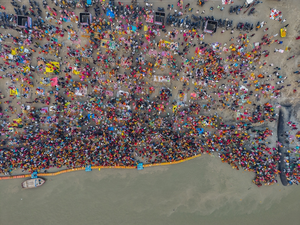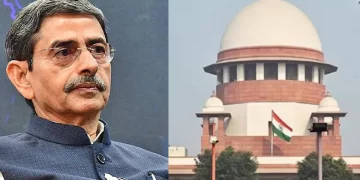Mahakumbh Nagar: Ahead of the final Amrit Snan at the Maha Kumbh on Basant Panchami, top officials are stressing compliance with Chief Minister Yogi Adityanath’s directive of ‘zero error.’
The crowd for the Basant Panchami Snan is already swelling, with nearly 90 lakh devotees having taken a dip in the Ganga and at the Sangam by 12 pm Sunday. Additionally, since January 13, over 33.61 crore devotees have taken a dip at the Maha Kumbh.
VIDEO | Maha Kumbh 2025: Drone visuals of devotees taking holy dip in Triveni Sangam on the occasion of Basant Panchami.#MahaKhumbWithPTI
(Full video available on PTI Videos – https://t.co/n147TvrpG7) pic.twitter.com/GrAjHMkGWo
— Press Trust of India (@PTI_News) February 2, 2025
The emphasis on ‘zero error’ comes in the wake of a deadly stampede January 29 that left at least 30 people dead and 60 others injured.
To ensure strict adherence to safety measures, the Uttar Pradesh government has deployed two senior IAS officers who were part of the team that successfully managed the 2019 Ardh Kumbh to oversee the smooth conduct of the Mela.
Ashish Goyal and Bhanu Chandra Goswami, who have hands-on experience in administration in Prayagraj, including a deep insight into crowd management and inter-agency coordination during the 2019 Ardh Kumbh, have joined Mela Adhikari Vijay Kiran Anand, forming a trio that was part of the mega fair six years ago.
Additional Director General of Police Bhanu Bhaskar himself is overseeing the crowd control measures in the fair area.
Following the tragic crowd crush at Sangam Nose on Mauni Amavasya (January 29), which resulted in casualties, the chief minister visited Prayagraj for the first time after the incident Saturday.
During his visit, Adityanath inspected the incident site and went to hospitals to check on the condition of the injured. In a review meeting regarding the Basant Panchami snan preparations, he instructed officials to ensure the event is executed “without any errors”.
On Sunday morning, ADG Bhaskar arrived at the Integrated Command and Control Centre (ICCC) located in the Mela Authority building. There, he monitored the entire fair area, intersections and entry points via large screens, and personally issued loudspeaker instructions to clear the ghats of the crowd.
Speaking over the mic from the ICCC, he advised the devotees: “Please do not linger unnecessarily on the ghats after bathing; clear the area so that other devotees may bathe. Do not eat or drink on the ghats and go to designated areas for refreshments.”
Bhaskar further directed police officers at the centre to ensure that no crowd gathers anywhere on the ghats and that devotees promptly leave for their next destination after bathing.
Rupam Chandra, returning after taking a holy dip, told PTI, “After bathing at the Sangam ghat, devotees are being cleared away. Police are blowing their whistles in every direction to ensure the ghats are emptied. That is why we left immediately after bathing.”
An official from the Mela administration stated that the entire police force has been instructed to pay special attention to crowd control throughout the fair area. Meanwhile, administrative officers Bhanu Chandra Goswami and Ashish Goyal, who have arrived from Lucknow, are assisting the Mela administration by sharing their previous experiences.
In the 2019 Kumbh, Goswami served as the Vice Chairman of the Prayagraj Development Authority, while Goyal was the Divisional Commissioner of Prayagraj.
Meanwhile, Mahant Ravindra Puri, President of the All India Akhada Parishad, appealed to the devotees by stating that it is believed that the five kos of Prayagraj are considered part of the Sangam. Therefore, devotees receive the merit of the Maha Kumbh by bathing anywhere from Phaphamu to Arail.
He added, “The area of the Sangam is limited, so we request all devotees not to create unnecessary crowding in that area.”
Prime Minister Narendra Modi is proposed to visit Maha Kumbh Nagar February 5. In view of this, the next few days are expected to be challenging for the Mela administration and the police.
During the Mauni Amavasya dip, a crowd crush at Sangam Nose resulted in the death of 30 people and left 60 injured. Police said due to overcrowd the devotees jostled for space, breaking a barrier that led to the stampede.
The Amrit Snan is the grandest and most sacred ritual of the Maha Kumbh Mela, attracting millions of pilgrims from around the world to the banks of the Triveni Sangam. Devotees believe that taking a dip during such special celestial alignments washes away their sins and paves path for ‘moksha’, or salvation.
Among the key attractions of the Amrit Snan is the magnificent procession of saints and ascetics, including the ash-smeared bodied Nagas, from the Akharas (monastic orders).
The dates for the Amrit Snan are determined based on astrological combinations of the Sun, Moon, and Jupiter, which are believed to enhance the spiritual power of the sacred rivers. In this Maha Kumbh, the first two Amrit Snan were January 14 (Makar Sankranti) and 29 (Mauni Amavasya) and the next February 3 (Basant Panchami).
According to Hindu calendar, Basant Panchami falls on the day of Magh Shukla Panchami. This date marks the auspicious arrival of the spring season.
Apart from Amrit Snan dates, there are three other major bathing dates one of which was January 13 (Paush Purnima) while the two others are February 12 (Maghi Purnima) and 26 (Mahashivratri), which also marks the culmination of the once-in-a-12-year-event.
PNN & Agencies






































